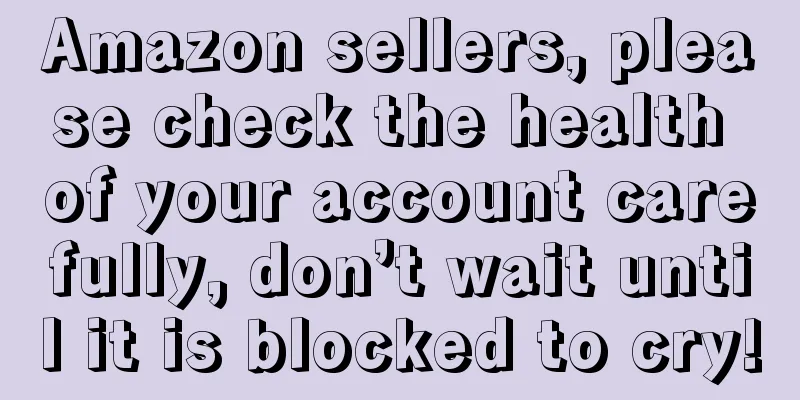Amazon sellers, please check the health of your account carefully, don’t wait until it is blocked to cry!

|
I believe that many sellers have been heartbroken because of Amazon account freezing and listing blocking. The same world, the same tiredness! In order to avoid "stepping into the same pit", sellers must find out the hidden dangers in the seller's account before Amazon launches an investigation, and solve them as soon as possible to prevent the account from being blocked. If you find a buyer complaining about product quality issues, you can take timely remedial measures to save the situation before things get out of hand. Or, if you fail to meet Amazon's key performance indicators, you can find out early and develop relevant countermeasures. This article will introduce the steps to help sellers find security risks in their accounts, which will help sellers develop a complete plan to protect their business, run their stores well, and make their stores stable and growing. Before understanding the formal inspection steps, sellers need to understand three guidelines: When checking the health of your account, you should check the health of the entire account. You can try to analyze the account from the perspective of the Seller Performance team and do a thorough risk assessment of your account. Be careful not to ignore the seller performance notifications sent by the Amazon system, otherwise you may miss the reminder of account security risks. You should take the initiative to take effective actions to protect your account. Under Amazon's current policy, if you do not take effective actions or ignore Amazon's notifications, the risks you will incur are unbearable. Make account health checks a daily routine. Put it on your calendar as a habitual task, write down the process to follow, and use tools like checklists to ensure that the account health check process is completed completely and correctly every time. After understanding the above guidelines, you can officially enter the account health check step. Sellers can check the account status by following the steps below: First, you need to check the health of your account by checking the product quality, and then you can check the overall business operation. For example, understand what caused your listing to be frozen? Have you taken appropriate steps to evaluate these issues? What reasons will sellers have to complain about product quality in the future? Specifically, sellers need to check the following points: (1) Listing Check whether the product information in the listing is accurate and consistent? Are there any misleading advertising slogans that mislead buyers? Is the listing title set appropriately? (2) Documents You need to make sure you have the relevant supplier certification documents recognized by Amazon. To avoid buyers complaining about the authenticity of the product, it is recommended that you ask the supplier for relevant certification letters. Because you never know when Amazon will ask you for product-related invoices, even for your own brand products. (3) Operation/training Make sure everyone who touches your Amazon account knows what they are doing. Given that Amazon account management involves a variety of different policies and strategies, if you have time, give your employees proper on-the-job training. You can list the Amazon policies and strategies that different employees need to pay attention to based on their different divisions of labor. Otherwise, your account is likely to be frozen because of repeated mistakes made by employees. (4) Customer Service Respond to buyers’ messages promptly! Amazon requires sellers to respond to buyer inquiries within 24 hours, and if you fail to do this, you will violate Amazon’s guidelines. Moreover, the longer the buyer waits, the more likely they are to file a complaint, which means you have given the buyer a bad shopping experience, which may cause Amazon to freeze your listing. (5) Product transportation and packaging Are the items you sell likely to be damaged in transit? Whether you ship your own products or use FBA, make sure your product packaging keeps them intact. If products are being returned for being “damaged in transit” or “defective,” then you need to seriously consider whether you should upgrade your packaging. It may cost more, but if it means you won’t receive these types of complaints again, it may be worth it. (6) Product procurement Simply put, product quality depends on your supplier. If you are doing private label, do your suppliers produce high-quality products for you? Do you find problems in the random samples they send you? If you find problems, then your buyers will most likely encounter the same problems. If you resell products, your supplier must be an authorized distributor or at least a well-known supplier of the brand you are joining. If they are just acting as a middleman and the product has changed hands many times, the documents provided by your supplier may be difficult to convince Amazon investigators. In addition, it is best to have the supplier's letter of authorization in the letter of authorization you ask for, which will be more convincing. In addition, be sure to take the time to check the type of invoice the supplier will issue to you. If it cannot pass the inspection of Amazon's product quality team, then ask the supplier to change the invoice type or you can find another supplier. Amazon has set up multiple seller performance indicators to evaluate seller performance, including order defect rate (ODR), A-to-Z claims, and refunds. You need to carefully understand the possible dissatisfaction of buyers from each indicator. Are there any buyers complaining about product quality or condition in your buyer feedback? Is your order defect rate (ODR) high? Do you often cancel orders? Discover these problems as early as possible and stop losses in time before bad indicator data damages your account health. If your account performance index is too low, you can prepare an action plan in advance to prevent Amazon from issuing a warning to you or even freezing your account. When your index is below the standard, Amazon may ask you to provide a reliable action plan, clearly state the reasons for the low index, and give detailed measures to solve the problem of the account. Sellers should check your account frequently to prepare for foreseeable problems and prevent confusion in your account. Specific checks: (1) Review the buyer’s reasons for return Start by understanding the buyer’s reasons for return. This way you can gradually understand the underlying issues in your account, including: product quality, listing accuracy, product status rating, inventory, transportation, pricing, etc. Therefore, first, you need to download the FBA customer returns report in the Reports→Fulfillment section of the Seller Center. This report contains all return data, including the reason why the buyer requested a return. Then, look for products with high return rates and other frequent return reasons. For example, if multiple buyers report that a particular product was damaged during shipping, you can add more protective padding. If buyers question the authenticity of your product, it may be because the listing you set up is very different from the product you sell. Be aware of this, as there are many cases where accounts have been blocked due to improper listing settings. (2) Do not miss any ASIN that receives the Amazon red flag Amazon often gives sellers a red flag warning when an ASIN is complained by a large number of users, returned or generates a bad buyer experience. After receiving these warning notifications, sellers need to conduct a detailed inspection of these ASINS to find out the root cause of the problem and finally come up with a feasible solution. Buyers’ complaints come in all kinds of forms. Sellers should not be surprised by the “strange” things, but should deeply understand and calmly analyze why buyers do not like the products they received. Again, don’t ignore recurring issues in buyer complaints, as this can cause you more trouble. If you receive a notification of a “soft block” listing from Amazon, be sure to pay attention. These notifications will give you valuable clues. For example, Amazon may allow you to list an ASIN on your own and show you a small number of complaints. These complaints may indicate that buyers complained or returned the product because of some problems in the product detail page. But regardless of whether Amazon points these issues out to you, sellers need to carefully check to find information in your listings that may easily lead to misunderstandings among buyers. (3) Carefully review buyer feedback What are the issues that often come up in your buyers’ feedback? Are there obvious problems? Or are there specific ASINs that are particularly "blacklisted"? Have buyers reported that the product they received was very different from the seller's display? What steps can you take to proactively resolve the issue before Amazon freezes your account? Draft an action plan that can be implemented to reduce related complaints, thereby reducing the possibility of your account being targeted or even frozen. In recent months, many seller groups and forums have been flooded with complaints and discussions about hijacked listings, fake product reviews, and fake goods. It is expected that such public opinion will continue to heat up in 2019 until Amazon takes effective action to deal with this situation. But before that, what methods do you have to deal with malicious sabotage from your peers? If you are a seller with your own brand but have not registered a trademark, you need to act now to avoid others registering a trademark before you. If you already have your own registered trademark, have you registered for Amazon brand record? Knowing this can better protect your brand products. If you purchase items from other platforms and then resell them, you should keep an eye on your listings. Once it is tampered with by malicious sellers, you will be able to find it immediately. If necessary, you can temporarily remove the listing. Sellers also need to be careful about fake reviews. Giving fake reviews to competitors is one of the ways malicious buyers attack competitors. They may give you bad reviews or a lot of good reviews. The former will damage your seller index, while the latter will lead to Amazon's investigation and even freeze your seller account. Therefore, once you find a large number of unidentified reviews in your listing, you must deal with them in time. From the day the malicious seller leaves the review, you need to ask Amazon to delete the fake review within 90 days. (1) Apply for ASIN restoration "Amazon removed the ASIN and deprived me of the right to sell best-selling products. What should I do?" Have you ever encountered such a problem? When you encounter such a problem, you first need to know the reasons behind Amazon's actions. It may be that there are serious problems with your product that cause a lot of customer dissatisfaction. After understanding the reasons, you need to list these reasons and develop corresponding detailed solutions to avoid a large number of complaints in the future. Pay attention to writing these contents in the form of bullet points in a report, the length of which should not be less than one and a half pages, and submit it together when submitting an action plan to Amazon. This is the fastest way for sellers to restore their ASINs. (2) Ask Amazon to annotate your account Even if you don’t plan to sell the ASIN anymore, you should inform the Amazon Product Quality Team to freeze the listing. If you don’t have stock now, that’s fine. But if the investigator comes back and sees that you still have unresolved notifications, it’s too late to resolve them. If you remain silent, they will think you are not doing anything and are not capable of solving the problem, which will bring a bad shopping experience to the buyer. You should tell the investigator that you have found the problem with the product and decided to remove the product, let them know that you are listening to their opinions. If necessary, you can show them your FBA inventory removal order number. (3) Do not keep submitting unfreezing appeals If you submit a comprehensive and feasible action plan but it is rejected by Amazon, don’t give up. It may be because your action plan is missing something or the content is too messy. You need to reorganize it, make good use of bullet points and numbers, and delete those lengthy nonsense. This will make your action plan look more concise and clear. After you make the changes, if there is still no progress, and the Amazon investigator still does not read your revised action plan and sends you system messages over and over again, don't get angry. Calm down, re-write a new email, give a more convincing reason, and send the appeal to a higher-level team at Amazon for review. Be aware that an email can ruin your seller account or save your seller account from future losses. Having your account restricted or even frozen is tiring, but just complaining or getting angry is useless. You need to respond proactively, with both attitude and methods, to be more likely to gain the recognition of Amazon customer service. Once a consensus is reached, it will be easier to unfreeze the account. Text✎ Zhu Meiying/ Statement: When reprinting this article, the title and original text must not be modified, and the source and original link must be retained. |
>>: Keepa is charging a fee? Seller: What a rip-off!
Recommend
Shein's first-half revenue hit a record high and it is actively recruiting Amazon sellers
Ever since Temu chose the North American market as...
The largest online shopping group in the United States! 5 pictures to understand the consumption preferences of Generation Z
According to the latest research from eMarketer, a...
What is Kouka? Kouka Review
KouKua is a one-stop Amazon operation software tha...
What is a virtual overseas warehouse? Virtual overseas warehouse evaluation
The virtual overseas warehouse is a virtualized mo...
What is Small Business Academy? Small Business Academy Review
Small Business Academy is an online education depa...
What is Amazon Smile Logo Infringement? Amazon Smile Logo Infringement Review
Amazon's logo is a smiling pattern made up of ...
Delivery delay warning! Severe storms hit many parts of the United States, USPS issued a suspension notice!
<span data-docs-delta="[[20,"获悉,据外媒报道,12月1...
How popular is the “Barbie traffic”? It has also brought Barbie swimsuits to popularity!
The Barbie movie has grossed $1 billion at the glo...
Cross-border winter! How can small and medium-sized sellers save themselves under the new mask export regulations?
Today, I believe everyone has been flooded with th...
U.S. consumer confidence fell in August! Demand for electrical appliances is still rising!
U.S. consumer confidence fell in August, erasing c...
Walmart Cyber 5 results: traffic declines, sales increase
According to the latest report from DigitalCommerc...
Amazon Whole Foods orders drop sharply! Increased delivery fees cause dissatisfaction among Prime users!
It is learned that according to foreign media repo...
Inflation crisis looms over US holidays! Multiple categories will be hit hard!
<span data-docs-delta="[[20,"获悉,根据市场研究公司Nu...
Snowstorm warning! Ports are severely congested, and logistics conditions are getting worse!
Yesterday, the editor saw many sellers showing off...
What is Amazon Private Label? Amazon Private Label Review
Amazon's own brand does not mean that sellers ...









